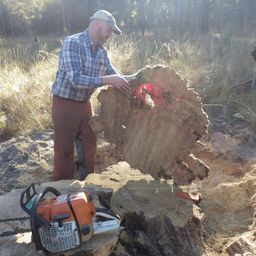
Joseph Marschall
Sessions in which Joseph Marschall participates
Wednesday 29 June, 2022
Fire-dependent red pine (Pinus resinosa Ait.) vegetation communities in the central Appalac...
Sessions in which Joseph Marschall attends
Monday 27 June, 2022
Blue Intensity (BI) is a cost-effective analytical method for measuring relative wood density in the rings of conifer tree species. Since early concept papers in the 1990s/2000s, there has been a recent explosion in the application of this method for both dendroclimatology and historical dating as well as other dendro-disciplines. The beauty of BI is that the analytical costs, mainly related to the cost of a h...
Tuesday 28 June, 2022
Climate change poses an existential threat to trees, given our understanding of the importance of climate in shaping their geographic distributions. Climate envelope models are commonly used to predict how species will respond to climate change. These models give rise to the leading edge-trailing edge paradigm for range change: populations at the cool edge of a species’ distribution are expected to benefit from warming, whereas populations at the warm edge are expected to decline. We chall...
Forest disturbances and tree growth are major drivers of dynamics and long-term carbon storage in forests. Combining forest inventory data and tree-ring analysis allows for a retrospective estimate of aboveground forest biomass (AGB) and disturbance dynamics at decadal to centennial scales, both being directly related to net primary productivity (NPP). We used this combined approach to estimate precisely-dated ages of aboveground carbon in over 20 temperate old-growth forests in Western Eu...
Evidence of volcanic cooling and its human impacts has been described for various regions of the globe over the past several centuries to millennia, derived from paleoclimatic and historical data. Due to its remote location, detailed accounts of such impacts over Northwestern North America (NWNA) are still quite limited. Here we use a newly expanded tree-ring density network (derived from blue intensity as well as maximum latewood density parameters) to assess the climatic and human impact...
"Emerging in the early 20th century, the scientific study of tree-rings has a rich but under-cultivated history. This project reviews the historiography (or the history of historical writing) of dendrochronology. From the pioneering work of A.E. Douglass and others to the establishment of institutions dedicated to advancing dendrochronology by the 1950s, the field has secured its place as an ensemble of techniques to interpret tree rings, with applications in archeology, climatology, ecolo...
Ultra high resolution imaging is becoming standard across the sciences and must be a priority for dendrochronology. Large format scanners fail to resolve micro rings and the anatomical structures of increasing scientific interest. Meanwhile, current software limitations include cost, user experience, data management flexibility, and capacity for handling large file sizes. We argue for a new paradigm and present a technology framework that integrates gigapixel macro photography, a cloud-hos...
Annually resolved subfossil kauri (Agathis australis) trees, recovered from bogs in northern New Zealand, provide unique insights into past climate events over multi-millennial timescales. Their tree-rings faithfully capture annually resolved information about climate and carbon dynamics occurring during their lifespan. Preserved material has contributed tree-ring chronologies spanning much of the Holocene and extending into the late Pleistocene (i.e. the last 50,000 years). A recently dis...
Fire regimes shaped forest ecosystems for centuries in the southwestern United States prior to a century of fire exclusion. Tree-ring fire history studies have been vital to our ecological understanding of fire regimes and to inform management. Regional-scale synthesis efforts have revealed the strong connection between fire and climate, but by focusing on coarse-scale patterns over time, such studies may have overlooked finer-scale interactions of fire, climate, vegetation, and human acti...
We examined the effects of large-scale modes of climate variability on regional fire history of red pine forests of eastern North America using (a) a network of sites with fire scar-based reconstructions of fire histories over 1675-1900 AD, (b) reconstructions of circulation indices (1675-2019), and (c) the 20th century observational records of weather (1950-2019) and fire (1959-2019). In exploring climate-fire relationships over the distribution range of red pine, we hypothesized that the...
Indigenous land stewardship and mixed-severity fire regimes both encourage landscape heterogeneity and the relationship between them is an emerging area of research. To contribute to this exploration, we reconstructed the historical fire regime of Ne Sextsine, a 6000-ha dry, Douglas-fir-dominated forest in the traditional territory of the T’exelc (Williams Lake First Nation) in British Columbia. Between 1550 and 1982 CE, we found median fire intervals of 15 years at the plot-level and 4 ye...
There is a growing need for improved methods and approaches for managing wildfires in British Columbia, as uncharacteristically large wildfires exceed government capacities for control and suppression. The 2018 Tweedsmuir complex fire exceeded half a million hectares, negatively impacting several endangered species and the ecosystems they depend on. Tweedsmuir Provincial Park is one of BC’s largest protected areas and plays a critical role in connecting diverse landscapes and allowing plan...
The most frequent fire regimes in the world exist in environments that balance maximum fuel production and maximum fire occurrence potential. Often these environments exist at low elevations, correspond to subtropical climates, and have long growing seasons that push the limits of reliable annual ring formation. Historical fire regimes in ecosystems with these conditions are poorly studied. We investigated fire scarring in such conditions in southwestern Georgia, USA and successfully const...
Thursday 30 June, 2022
(by bus, max 92 people)Designed for visitors and newcomers, the tour is based on the pleasure...